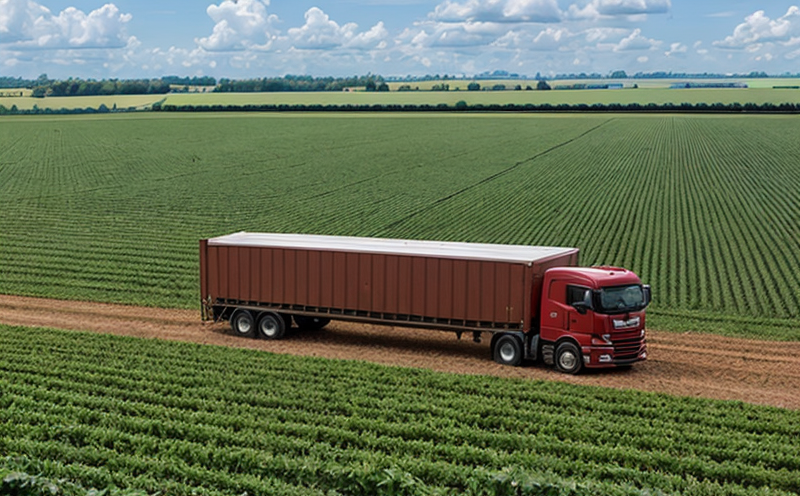Load Bearing Capacity Testing of Bulk Containers
The load-bearing capacity testing of bulk containers in agriculture and forestry is a critical process that ensures the integrity and safety of packaging used to transport goods such as grains, seeds, and other agricultural products. This service aims to provide accurate and reliable data on the maximum weight that can be safely loaded into these containers without causing structural damage or compromising product quality.
Understanding the load-bearing capacity is essential for optimizing transportation efficiency while maintaining product freshness and safety. For instance, in the case of grain transport, improper loading can lead to spillage during transit, increased fuel consumption due to inefficient weight distribution, and potential contamination from moisture seepage. By conducting thorough load-bearing capacity tests, we ensure that the containers are designed and loaded optimally.
The testing process involves several key steps: initial specimen preparation, equipment calibration, application of loading forces in incremental stages, monitoring for structural deformation or failure, and final analysis to determine the maximum sustainable weight. This service is particularly important given the diverse range of agricultural goods with varying densities, moisture contents, and bulk volumes.
One of the primary challenges in this testing process is ensuring that the specimen preparation accurately reflects real-world conditions. For example, grains should be packed as they would be during transportation: loose-packed or compacted to simulate different transport scenarios. This allows for a more precise assessment of how the container will perform under actual operational conditions.
The equipment used in this testing must also be capable of withstanding the high loads involved without compromising accuracy. High-capacity load cells and hydraulic jacks are commonly employed to apply controlled forces to the specimen containers. The data collected during these tests is then analyzed using sophisticated software that can provide insights into the structural integrity of the container.
Another critical aspect of this service is the interpretation of test results, which must be done with a deep understanding of both materials science and agricultural logistics. This ensures that the recommendations provided to clients are not only accurate but also actionable. For instance, if a particular type of grain consistently causes premature failure in containers, we can advise on using different packaging or adjusting loading practices.
The results of these tests are crucial for quality managers, compliance officers, and R&D engineers who need to ensure that their products meet both internal and external standards. By providing detailed reports on the load-bearing capacity, these professionals can make informed decisions about container design, material selection, and transportation logistics. This not only enhances operational efficiency but also contributes to environmental sustainability by reducing waste and optimizing resource use.
Scope and Methodology
| Step | Description |
|---|---|
| Specimen Preparation | Packing the container with agricultural goods according to real-world conditions, including varying densities. |
| Equipment Calibration | Ensuring all load cells and hydraulic jacks are accurate within specified tolerances. |
| Load Application | Incrementally applying loads to the container until failure or maximum capacity is reached. |
| Data Collection | Recording deformation, stress levels, and any signs of structural damage during loading. |
| Analysis | Analyzing collected data to determine the maximum sustainable weight for each specimen. |
| Standard Compliance | Description |
|---|---|
| ISO 17845:2013 | International standard for testing load-bearing capacity of bulk containers in agricultural applications. |
| ASTM D6914-18 | American Society for Testing and Materials standard for determining the crush strength of bulk packaging materials used in agriculture. |
| EN 12537:2009 | European standard for load-bearing capacity testing of agricultural containers. |
The scope and methodology for this service are meticulously planned to ensure that the results are both accurate and reliable. Compliance with international standards such as ISO 17845:2013, ASTM D6914-18, and EN 12537:2009 guarantees that our testing process adheres to industry best practices and ensures consistency across different regions.
Customer Impact and Satisfaction
The load-bearing capacity testing service has a significant impact on the agricultural sector by enhancing product quality, operational efficiency, and environmental sustainability. For customers like quality managers and compliance officers, this service provides critical data that can be used to optimize transportation logistics and ensure regulatory compliance.
R&D engineers benefit from our testing as they gain insights into how different materials and loading practices affect container performance. This information is invaluable for developing new packaging solutions that meet both functional and sustainability goals. Procurement professionals also see value in this service, as it helps them select the most appropriate containers for their specific needs.
Customer satisfaction is a key metric we track closely. Our clients appreciate the detailed reports and recommendations provided, which enable them to make informed decisions about packaging design and transportation logistics. Regular feedback from our customers reinforces our commitment to excellence in this service.
Environmental and Sustainability Contributions
The load-bearing capacity testing of bulk containers plays a crucial role in promoting environmental sustainability within the agricultural sector. By ensuring that containers are designed to safely carry maximum loads, we reduce the need for additional packaging or multiple trips during transportation, thus minimizing fuel consumption and greenhouse gas emissions.
Our service also contributes to waste reduction by helping clients select containers that can withstand higher loads without compromising product quality. This not only extends the life of each container but also reduces the amount of waste generated from premature failures. Additionally, by optimizing loading practices based on test results, we help minimize the risk of spillage and contamination during transit.
Furthermore, our adherence to international standards ensures that the testing process is consistent with global best practices in sustainable agriculture. This aligns with broader efforts to reduce environmental impact while maintaining high-quality agricultural products.





